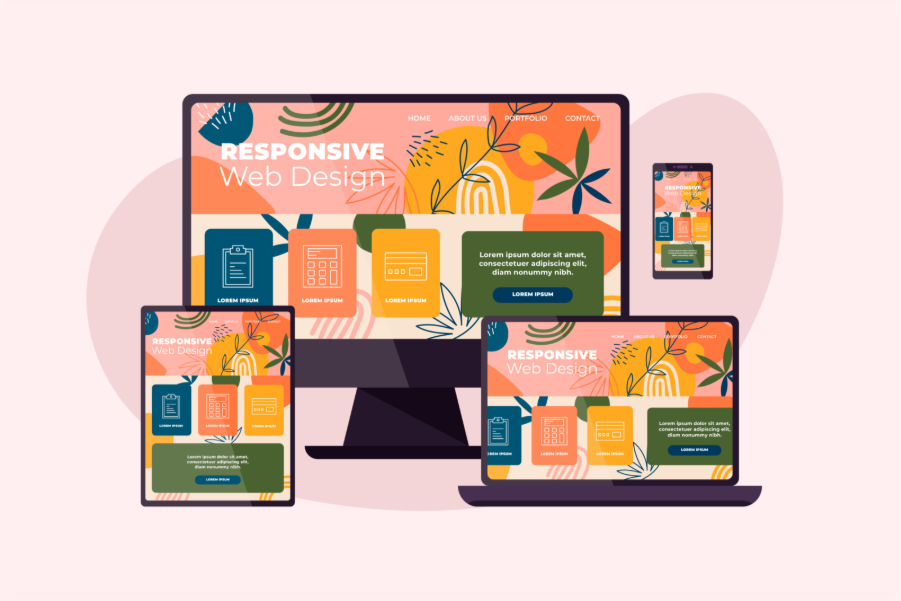Introduction
In today’s digital landscape, having a responsive website is no longer optional. Businesses of every size need websites that work seamlessly across desktops, tablets, and smartphones. Customers expect smooth browsing, no matter the device. If a site does not load well on their screen, they leave.
The link between user experience and conversion rates is clear. A site that adapts to users’ needs keeps them engaged, builds trust, and encourages action. That action may be filling out a form, buying a product, or contacting a business. Companies that invest in WebHill understand that responsive design drives conversions.
What is Responsive Web Design?
Responsive web design is a method of building websites that automatically adjust their layout based on screen size. Whether someone visits from a laptop, a tablet, or a mobile phone, the content looks good and remains easy to use.
Definition and key features
A responsive website uses flexible grids, images, and CSS media queries. This means no horizontal scrolling, no zooming issues, and a consistent experience for every visitor.
Mobile-first vs. responsive approach
A mobile-first approach starts with designing for small screens first, then scaling up. Responsive design ensures the site adapts across all devices, large or small.
Differences from adaptive design
Adaptive design uses multiple fixed layouts. Responsive design flows naturally, adapting with flexibility. Responsive websites need less maintenance and provide better long-term scalability.
Responsive Web Design Benefits for Businesses
Businesses benefit directly from responsive design because it improves customer experience across all devices.
Consistent branding across devices
Your logo, colors, and message should appear the same whether a user visits on a desktop or a smartphone. Responsive design maintains consistent branding, which builds trust.
Improved usability and navigation
Clear menus, readable text, and touch-friendly buttons make navigation smooth. Users stay longer, lowering bounce rates.
Better engagement metrics
Time on page, lower exit rates, and higher interaction levels all improve when the design works seamlessly. These signals show Google that your site delivers value.
For local growth, working with a professional seo company markham can align responsive design with optimized search strategies.
The Role of UX Design in Conversion Optimization
User experience (UX) design has a powerful impact on conversions.
How good UX builds trust
When users find a site easy to use, they trust it. Trust leads to completed purchases, sign-ups, or inquiries.
Reducing friction in the user journey
Every extra step lowers the chance of conversion. UX design simplifies forms, menus, and checkouts to remove friction.
Accessibility and inclusivity benefits
Accessible websites reach more people, including those with disabilities. Inclusivity widens your audience and improves brand reputation.
Mobile-Friendly Design as a Conversion Driver
Mobile use dominates online activity today.
Why mobile traffic dominates conversions
Most users search and shop on mobile devices. A mobile-friendly site ensures you meet users where they are.
Case studies/statistics on mobile vs desktop performance
Studies show that users are more likely to abandon a purchase if a site does not work well on mobile. Businesses that optimize mobile experiences see higher sales and better lead generation.
Speed and UX – The Critical Connection
Website speed is essential for conversions.
How load times affect bounce rates
Users expect sites to load in seconds. If it takes too long, they leave before the page even loads.
Google’s Core Web Vitals as ranking and conversion signals
Core Web Vitals measure performance factors like load time, interactivity, and layout stability. Meeting these metrics helps sites rank better and convert more.
For businesses looking to scale in local areas, working with experts in seo services mississauga ensures your responsive design also meets technical SEO standards.
Mapping the User Journey with Responsive Design
Responsive design is about guiding users smoothly from entry to conversion.
Guiding users from landing page to checkout
A clear path from a landing page to a checkout form reduces drop-offs. Responsive design ensures every step works across devices.
Simplifying navigation paths
Menus should be short, clear, and easy to access. Too many clicks reduce conversion chances.
Mobile-friendly CTAs (click-to-action buttons)
CTA buttons must be large enough for touchscreens and placed where users expect them.
Conversion Rate Design Principles
Conversion rate design applies principles that encourage users to act.
Optimizing forms and checkout
Short forms with fewer fields work best. A smooth, one-page checkout helps avoid cart abandonment.
Visual hierarchy and CTA placement
Using color, contrast, and spacing, designers guide users’ eyes to important actions like “Buy Now” or “Sign Up.”
Trust signals (security badges, reviews, guarantees)
Security badges, customer reviews, and guarantees give users confidence to proceed with purchases or sign-ups.
Real-World Examples of Responsive Design Boosting Conversions
Many companies have seen measurable results after adopting responsive design.
Before/after redesign case studies
Retailers have seen sales increase by double digits after switching from non-responsive to responsive websites.
Industry-specific examples
B2B companies gain more leads when forms are easier to fill out on mobile. Local businesses see more calls and bookings when their contact buttons are mobile-friendly.
How to Get Started with Responsive Web Design
If your site is outdated, starting a redesign is crucial.
Key steps for a redesign project
Begin with a website audit. Identify usability problems, slow pages, and poor layouts. Set clear goals before redesigning.
Choosing the right web design agency
Work with an agency that specializes in responsive design and understands SEO. This ensures your site is not only user-friendly but also optimized for search engines.
Avoiding common mistakes
Do not overload the site with unnecessary features. Keep design clean, simple, and focused on conversions.
If you are ready to make your site responsive and conversion-focused, you can reach out through the contact page.
Conclusion
Responsive web design is essential for modern businesses that want higher conversions. It aligns user experience, mobile accessibility, and speed optimization into one strategy. Companies that adopt it see stronger engagement, higher trust, and more sales. Partnering with the right experts ensures your website drives measurable results and stays competitive.
FAQ
1. Why is responsive design important for conversions?
It improves usability, builds trust, and ensures that users can complete actions smoothly on any device.
2. Does mobile design matter more than desktop today?
Yes. Most users browse and shop on mobile, so mobile optimization directly impacts conversion rates.
3. How does page speed affect conversion rates?
Slow pages increase bounce rates. Fast, responsive sites keep users engaged and improve conversions.
4. What role does UX play in responsive design?
UX ensures the site is intuitive, accessible, and friction-free, leading to higher trust and more conversions.
5. How can I start improving my site’s responsiveness?
Work with a professional design and SEO team that specializes in responsive web design, beginning with a full audit and clear strategy.



